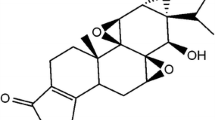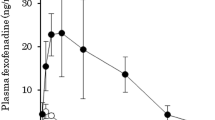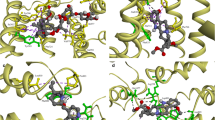Abstract
Purpose. Recently, we clarified the inhibitory effects of 13 kinds of 1,4-dihydropyridine calcium antagonists on human cytochrome P450 (CYP) 3A4. It has been reported that the substrates and/or inhibitors are overlapped between CYP3A4 and P-glycoprotein (P-gp). The purpose of this study was to investigate the inhibitory effects of 13 kinds of 1,4-dihydropyridine calcium antagonists on P-gp-mediated transport in order to evaluate the overlapping specificity of the inhibitors between P-gp and CYP3A4.
Methods. The transcellular transports of [3H]daunorubicin or [3H]digoxin by monolayers of LLC-GA5-COL150 cells in which P-gp was overexpressed were measured in the presence or absence of the 1,4-dihydropyridine calcium antagonists.
Results. The transport of [3H]daunorubicin was strongly inhibited by manidipine, barnidipine, benidipine, (−)-efonidipine, nicardipine, (+)-efonidipine, and amlodipine with the IC50 values of 4.6, 8.6, 9.5, 17.3, 17.5, 20.6, and 22.0 μM, respectively. The transport of [3H]digoxin was strongly inhibited by benidipine, nicardipine, barnidipine, and manidipine.
Conclusions. It was clarified that 13 kinds of 1,4-dihydropyridine calcium antagonists have different inhibitory potencies and substrate specificities to the transport of [3H]daunorubicin or [3H]digoxin. Some compounds did not demonstrate the overlapping specificity for inhibition between P-gp and CYP3A4. It was also clarified that ni- cardipine, benidipine, manidipine, and barnidipine were strong inhibitors of P-gp as well as CYP3A4.
Similar content being viewed by others
REFERENCES
M. M. Gottesman and I. Pastan. Biochemistry of multidrug resistance mediated by the multidrug transporter. Annu. Rev. Biochem. 62:385–427 (1993).
V. J. Wacher, C.-Y. Wu, and L. Z. Benet. Overlapping substrate specificities and tissue distribution of cytochrome P450 3A and P-glycoprotein: Implications for drug delivery and activity in cancer chemotherapy. Mol. Carcinogen. 13:129–134 (1995).
R. K. Kim, C. Wandel, B. Leake, M. Cvetkovic, M. F. Fromm, P. J. Dempsey, M. M. Roden, F. Belas, A. K. Chaudhary, D. M. Roden, A. J. J. Wood, and G. R. Wilkinson. Interrelationship between substrates and inhibitors of human CYP3A and Pglycoprotein. Pharm. Res. 16:408–414 (1999).
C. Wandel, R. B. Kim, S. Kajiji, F. P. Guengerich, G. R. Wilkinson, and A. J. J. Wood. P-glycoprotein and cytochrome P-450 3A inhibition: Dissociation of inhibitory potencies. Cancer Res. 59: 3944–3948 (1999).
M. Katoh, M. Nakajima, N. Shimada, H. Yamazaki, and T. Yokoi. Inhibition of human cytochrome P450 enzymes by 1,4-dihydropyridine calcium antagonists: Prediction of in vivo drug-drug interactions. Eur. J. Clin. Pharmacol. 55:843–852 (2000).
J. M. Ford and W. N. Hait. Pharmacology of drugs that alter multidrug resistance in cancer. Pharmacol. Rev. 42:155–199 (1990).
A. Ramu, R. Spanier, H. Rahamimoff, and Z. Fuks. Restoration of doxorubicin responsiveness in doxorubicin-resistant P388 murine leukaemia cells. Br. J. Cancer 50:501–507 (1984).
T. Saeki, K. Ueda, Y. Tanigawara, R. Hori, and T. Komano. P-glycoprotein-mediated transcellular transport of MDR-reversing agents. FEBS Lett. 324:99–102 (1993).
V. Höllt, M. Kouba, M. Dietel, and G. Vogt. Stereoisomers of calcium antagonists which differ markedly in their potencies as calcium blockers are equally effective in modulating drug transport by P-glycoprotein. Biochem. Pharmacol. 43:2601–2608 (1992).
K. Ueda, N. Okamura, M. Hirai, Y. Tanigawara, T. Saeki, N. Kioka, T. Komano, and R. Hori. Human P-glycoprotein transports cortisol, aldosterone, and dexamethasone, but not progesterone. J. Biol. Chem. 267:24248–24252 (1992).
Y. Tanigawara, N. Okamura, M. Hirai, M. Yasuhara, K. Ueda, N. Kioka, T. Komano, and R. Hori. Transport of digoxin by human P-glycoprotein expressed in a porcine kidney epithelial cell line (LLC-PK1). J. Pharmacol. Exp. Ther. 263:840–845 (1992).
O. H. Lowry, N. J. Rosebrough, A. L. Farr, and R. J. Randall. Protein measurement with the Folin phenol reagent. J. Biol. Chem. 193:265–275 (1951).
K. S. Lown, R. R. Mayo, A. B. Leichtman, H. L. Hsiao, D. K. Turgeon, P. Schmiedlin-Ren, M. B. Brown, W. Guo, S. J. Rossi, L. Z. Benet, and P. B. Watkins. Role of intestinal P-glycoprotein (mdr1) in interpatient variation in the oral bioavailavility of cyclosporine. Clin. Pharmacol. Ther. 62:248–260 (1997).
Y. Zhang, X. Guo, E. T. Lin, and L. Z. Benet. Overlapping substrate specificities of cytochrome P450 3A and P-glycoprotein for a novel cystein protease inhibitor. Drug. Metab. Dispos. 26: 360–366 (1998).
K. Ito, H. Kusuhara, and Y. Sugiyama. Effects of intestinal CYP3A4 and P-glycoprotein on oral drug absorption–Theoretical approach. Pharm. Res. 16:225–231 (1999).
K. Tanaka, M. Hirai, Y. Tanigawara, M. Yasuhara, R. Hori, K. Ueda, and K. Inui. Effects of cyclosporin analogues and FK506 on transcellular transport of daunorubicin and vinblastine via P-glycoprotein. Phram. Res. 13:1073–1077 (1996).
N. Kusunoki, K. Takara, Y. Tanigawara, A. Yamauchi, K. Ueda, F. Komada, Y. Ku, Y. Kuroda, Y. Saitoh, and K. Okumura. Inhibitory effects of a cyclosporin derivative, SDZ PSC 833, on transport of doxorubicin and vinblastine via human P-glycoprotein. Jpn. J. Cancer Res. 89:1220–1228 (1998).
E. Healy, M. Dempsy, C. Lally, and M. P. Ryan. Apotosis and necrosis: mechanisms of cell death induced by cyclosporine A in a renal proximal tubular cell line. Kidney Int. 54:1955–1966 (1998).
K. Shirakawa, K. Takara, Y. Tanigawara, N. Aoyama, M. Kasuga, F. Komada, Y. Sakaeda, and K. Okumura. Interaction of docetaxel (“Taxotere”) with human P-glycoprotein. Jpn. J. Cancer Res. 90:1380–1386 (1999).
K. Takara, Y. Tanigawara, F. Komada, K. Nishiguchi, T. Sakaeda, and K. Okumura. Cellular pharmacokinetic aspects of reversal effect of itraconazole on P-glycoprotein-mediated resistance of anticancer drugs. Biol. Pharm. Bull. 22:1355–1359 (1999).
J. Lessem and A. Bellinetto. Interaction between digoxin and the calcium antagonists nicardipine and tiapamil. Clin. Ther. 5:595–602 (1983).
K. E. Pedersen, J. L. Madsen, N. A. Klitgaard, K. Ljoer, and S. Hvidt. Non-interaction between nifedipine and digoxin. Dan. Med. Bull. 33:109–110 (1986).
G. D. Szklarz and J. R. Halpert. Molecular modeling of cytochrome P450 3A4. J. Comput.-Aided Mol. Design 11:265–272 (1997).
D. F. V. Lewis. The CYP2 family: models, mutants and interactions. Xenobiotica 28:617–661 (1998).
Author information
Authors and Affiliations
Rights and permissions
About this article
Cite this article
Katoh, M., Nakajima, M., Yamazaki, H. et al. Inhibitory Potencies of 1,4-dihydropyridine Calcium Antagonists to P-glycoprotein-Mediated Transport: Comparison with the Effects on CYP3A4. Pharm Res 17, 1189–1197 (2000). https://doi.org/10.1023/A:1007568811691
Issue Date:
DOI: https://doi.org/10.1023/A:1007568811691




